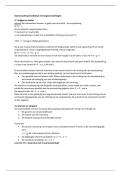Summary
Samenvatting - Nova Natuurkunde VWO4 - Energieomzettingen
- Course
- Level
Door middel van deze samenvatting maak je kennis met de energieomzettingen en hoe je deze kunt berekenen. Ook arbeid komt aan bod. geschikt voor leerlingen uit VWO 4. Dit is ook vaak voor een SE waar ik een 7,5 voor heb gehaald.
[Show more]



